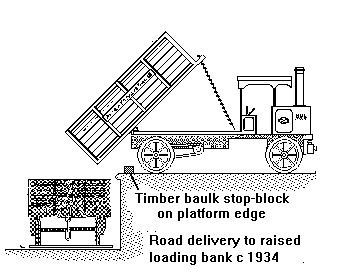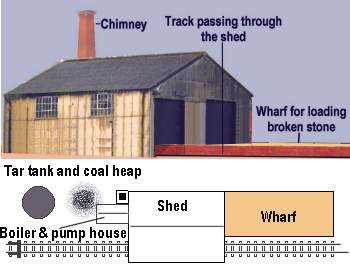Most building stone was shipped in railway company vehicles but some was transported in PO wagons, usually heavily built low sided types. Before the second world war concrete was not as widely used as today and kerb stones, paving flags, window and door lintels and even door steps were commonly made from stone (usually granite). PO stone wagons, generally low sided affairs, might appear (particularly if transporting large blocks) in a siding near a road or building construction site.
In 1815 the Macadam road appeared, this had a top coating of small stones and in N 'chinchilla sand' from the pet shop makes a passable representation. The top coating would typically be granite or (more likely) limestone although any rock that could be locally produced was used.
A quarry is a big thing, but many had no direct rail connection and used road carts and later lorries to deliver chippings to the local railway siding. No special facilities would be required for this, just a raised bank to allow the tip carts or tipper lorries to load the railway wagons. The sketch below was made from a photograph taken in the 1930's showing a steam tipper lorry (note the screw drive tipping mechanism) loading railway wagons on such a bank.
Fig___ Sketch of stone loading bank used for chippings

Similar arrangements have been used to load PCA stone hoppers and HEA coal hoppers, although the bank for these was rather higher. A more modern version of the same basic idea is shown below. This was in use in the late 1970's, again its a simple modelling option requiring only a siding along the rear of the layout. As well as the structure shown there would probably be a weighbridge on the track approaching the hopper and a couple of huts to serve as a stores and an office.
Fig___ Sketch of loading point with hopper feed

The dimensions shown are for N Gauge and again similar installations have been used with modern air braked rolling stock. More information on these loading facilities, including more elaborate designs, will be found in the section on Lineside Industries.
In the early 20th century there was an increasing demand for 'tar macadam' roads, in effect these were the existing Macadam road surface coates with limestone chippings coated in gas works tar. Generally the tar was heated on site and applied to a conventional macadamised road but some coated chippings were produced and these were shipped by rail. See also Appendix One - Roads and Road Works.
Limestone is the best material for tarred roads as the tar sticks well to this type of rock and stone chippings have been a regular cargo on the railway ever since. You would occasionally see a tarred chippings plant at the loading site for a quarry. These were neither large nor sophisticated, a simple corrugated iron shed similar to a goods shed would serve, although it would have a largish 'industrial' chimney as the tar was heated to make it flow.
Fig ___ Simple aggregate loading point and tarred chippings plant

See also Lineside Industries - Open Cast Mines & Quarries
The railways were not obliged to carry tarred stone as it would contaminate the wagon so tarred chippings were commonly moved in metal bodied PO wagons (the former Mike Bryant-Precursor Models iron PO wagon would be ideal for this). This traffic was never very common, it lasted from the early 1920's to the late 1930's. The wagon shown below, sketched from a photo in Peter Mathew's book on PO Wagons (see bibliography) is an all steel wagon equivalent to the three plank design built in 1923 to the then new RCH specification. The livery is that of the wagon builder although it may have operated in this livery for a time before being repainted in the owners colours.
Fig ___ PO steel bodied road stone or tarmacadam wagon

There are a couple of photographs of such a facility in the late Mike Lloyd's book The Tannant Valley Railway. I do not have my copy to hand bur from memory the siding was a dedicated private siding at some remote location, the loading bank was long enough to hold perhaps ten wagons in the open and a further three or four could fit inside the tin shed covering the tarred chippings plant at the buffers end of the siding.
Limestone and lime (produced by cooking limestone) were both shipped in PO wagons, usually owned by the quarry producing the stone. Broken limestone was used in large quantities by steel works and rakes of between ten and twenty wagons (all owned by either the quarry or the steel works) would be seen carrying this material.
Lime was usually made at or close to the quarry and was shipped loose or bagged by the single wagon load, as it would contaminate the wagons the railways were not obliged to carry it (although they often did). The PO wagons used for lime were either fitted with a roof (usually peaked) or with a horizontal bar to support a tarpaulin. Lime was mainly produced in fairly large kilns, often with a siding running up close to the sides of the kiln, these are discussed under Lineside Industries. Some lime from smaller quarries was however carted by road to a remote siding. I believe that where this was done a covered loading area was the norm.
Steel works consumed a lot of lime and it was widely used in agriculture where it was spread on acid or 'sour' soils. Other uses included antiseptic preparations, tanning leather, making chocolate and sugar refining and even for making perfume. It was used in the manufacture of caustic soda and as a water softening agent in hard water areas. Lime wagons can therefore appear on almost any layout.
In the mid 1990's there was a working for agricultural lime, moved in a rake of seven un-sheeted HEA hoppers, which surprised me as I thought lime was always covered over in transit. The lime was only loaded to within about eighteen inches of the top of the sides, possibly to reduce the amount blown out of the wagon or possibly because it weighs more than the coal the wagons were designed for (I am not sure which).
Lime was also essential for making 'bleaching powder' which was vital to the cloth industry. Although bleaching powder itself was rather unpleasant stuff I have found no record of wagons built to carry it, however as bleaching powder was very valuable the legislation on charging allowed the railways to earn a healthy profit on carrying it (beaching powder was selling for over a hundred pounds a ton at the time the railways were first being built). Bleaching powder was shipped in wooden barrels, heavily stained white, and the vans used to carry it would have some staining round the doors where they had been loaded.
Limestone is Calcium Carbonate (CaCO3) and lime is Calcium Oxide, CaO. If you add water to lime you get slaked lime, calcium hydroxide Ca(OH)2. Slaked lime mixed with water and sand is mortar, used in building brick and stone buildings, the lime reacts with carbon dioxide in the air to form calcium carbonate (limestone).
In quarries who's business was mainly the manufacture of lime the poor quality rock was often crushed and sold as road stone as a side line. Most of this road stone was sold for local use and most was taken out by road but short rakes of wagons carrying this stone might be seen in the vicinity of the quarry, in transit through the system or being unloaded in a goods yard close by the road works.